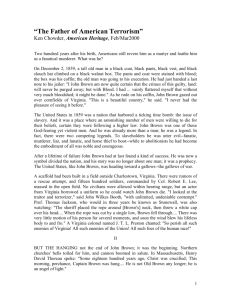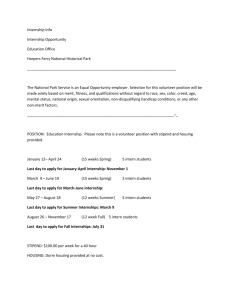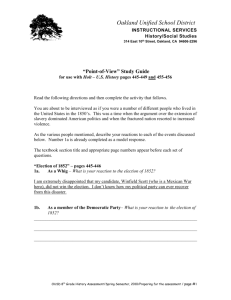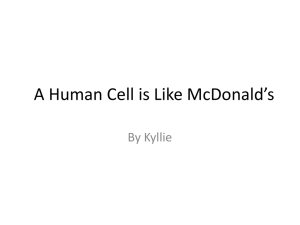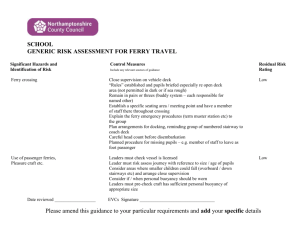Winter 2013 - Harpers Ferry Historical Association
advertisement
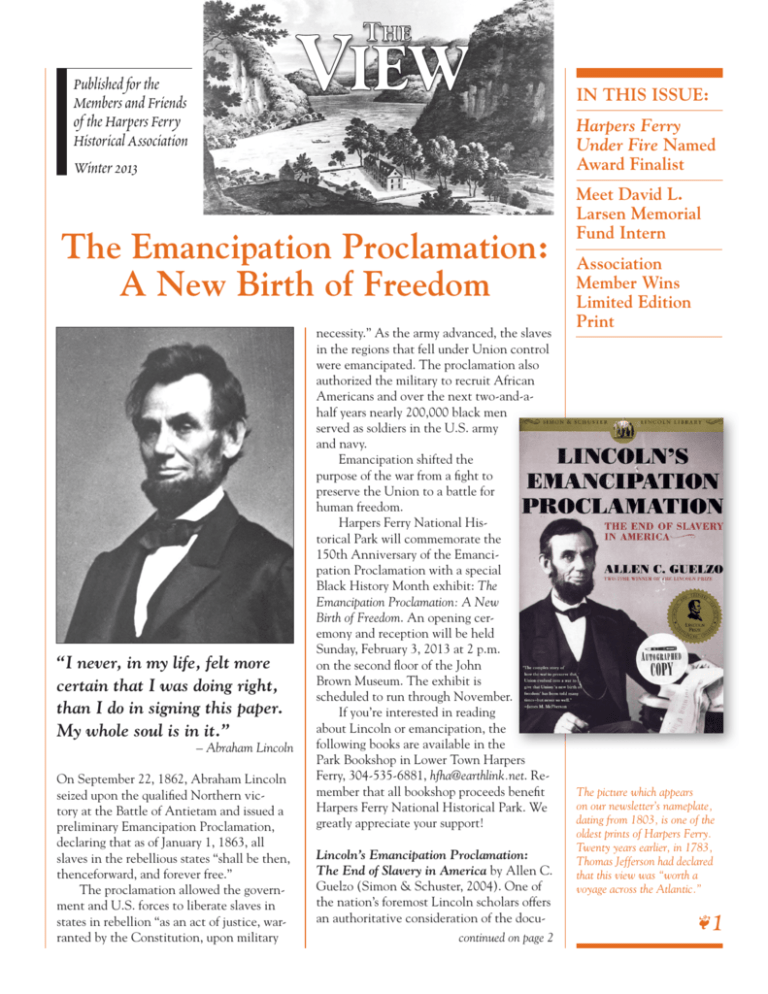
Published for the Members and Friends of the Harpers Ferry Historical Association Winter 2013 IN THIS ISSUE: Harpers Ferry Under Fire Named Award Finalist The Emancipation Proclamation: A New Birth of Freedom “I never, in my life, felt more certain that I was doing right, than I do in signing this paper. My whole soul is in it.” – Abraham Lincoln On September 22, 1862, Abraham Lincoln seized upon the qualified Northern victory at the Battle of Antietam and issued a preliminary Emancipation Proclamation, declaring that as of January 1, 1863, all slaves in the rebellious states “shall be then, thenceforward, and forever free.” The proclamation allowed the government and U.S. forces to liberate slaves in states in rebellion “as an act of justice, warranted by the Constitution, upon military necessity.” As the army advanced, the slaves in the regions that fell under Union control were emancipated. The proclamation also authorized the military to recruit African Americans and over the next two-and-ahalf years nearly 200,000 black men served as soldiers in the U.S. army and navy. Emancipation shifted the purpose of the war from a fight to preserve the Union to a battle for human freedom. Harpers Ferry National Historical Park will commemorate the 150th Anniversary of the Emancipation Proclamation with a special Black History Month exhibit: The Emancipation Proclamation: A New Birth of Freedom. An opening ceremony and reception will be held Sunday, February 3, 2013 at 2 p.m. on the second floor of the John Brown Museum. The exhibit is scheduled to run through November. If you’re interested in reading about Lincoln or emancipation, the following books are available in the Park Bookshop in Lower Town Harpers Ferry, 304-535-6881, hfha@earthlink.net. Remember that all bookshop proceeds benefit Harpers Ferry National Historical Park. We greatly appreciate your support! Lincoln’s Emancipation Proclamation: The End of Slavery in America by Allen C. Guelzo (Simon & Schuster, 2004). One of the nation’s foremost Lincoln scholars offers an authoritative consideration of the docucontinued on page 2 Meet David L. Larsen Memorial Fund Intern Association Member Wins Limited Edition Print The picture which appears on our newsletter’s nameplate, dating from 1803, is one of the oldest prints of Harpers Ferry. Twenty years earlier, in 1783, Thomas Jefferson had declared that this view was “worth a voyage across the Atlantic.” 1 Armory Superintendent Members Jo (Kuhn) Curtis in memory of Jim Kuhn and Alexander and Mary Murphy Brandywine, MD Dr. Robert Johnson Harpers Ferry, WV Ronald Jones Our Lady of Sorrows School Farmington, MI Nancy Myers, in Honor of Don Campbell Harpers Ferry, WV Jim and Suzanne Silvia Taunton, MA & Harpers Ferry, WV Paymaster Members Cynthia Gayton Harpers Ferry, WV Master Armorer Members Allison Alsdorf Harpers Ferry, WV Kirk Bradley Sanford, NC Karl Buchspics Willow Grove, PA Donald and Patricia Burgess Harpers Ferry, WV Robert Carson Fredericksburg, VA Hon. and Mrs. Thomas Curtis and Family Baltimore, MD Peter Dessauer Harpers Ferry, WV Kim and Frank Edwards Edgewood, MD Laurence Freiheit Berkeley Springs, WV Deborah Hale Harpers Ferry, WV continued on page 3 2 Emancipation Proclamation Continued from Page 1 ment that represents the most far-reaching accomplishment of our greatest president. Abraham Lincoln: A Photographic Story of a Life by Tanya Lee Stone (DK Publishing, Inc., 2005). Find out about Lincoln’s childhood on a frontier farm, how a struggling smalltown lawyer became president, and why he is one of America’s most revered and beloved leaders. Includes more than 100 photographs, artworks, and artifacts. Abe’s Honest Words: The Life of Abraham Lincoln by Doreen Rappaport, Illustrated by Kadir Nelson (Hyperion Books for Children, 2008). The passion for humanity that defined Lincoln’s life shines through in this momentous follow-up to Martin’s Big Words and John’s Secret Dreams. Told in Doreen Rappaport’s accessible, absorbing prose, and brought to life in powerful illustrations by Kadir Nelson, Abe’s Honest Words is an epic portrait of a truly great American president. The African-American Family in Slavery and Emancipation by Wilma A. Dunaway (Cambridge University Press, 2003). Wilma Dunaway contends that studies of the U.S. slave family are flawed by the neglect of small plantations and export zones and the exaggeration of slave agency. This book is unique in its examination of new threats to family persistence that emerged during the Civil War and Reconstruction. Included are several references to slaves in the Harper Ferry-Winchester area. Mothers of Invention: Women of the Slaveholding South in the American Civil War by Drew Gilpin Faust (University of North Carolina Press, 1996). In this awardwinning book, Dr. Faust, president of Harvard University, offers a compelling picture of the more than half-million women who belonged to the slaveholding families of the Confederacy during this period of acute crisis, when every part of these women’s lives became vexed and uncertain. Freedom is Coming: Songs of Freedom, Resistance, & the Underground Railroad, a 2-disc CD by the Underground Railroad Freedom Singers produced by the New Orleans Jazz National Historical Park. A fullcolor, 16-page booklet features photography from Stephen Marc’s book, Passage on the Underground Railroad. The uniquely American form of music we call jazz is rooted in the painful history of enslavement, which brought together many of the cultures of which jazz was born. Winter Quarters Excerpted from Harpers Ferry Under Fire: A Border Town in the American Civil War by Dennis Frye (HFHA, 2012): it was smuggled and abounded, and those men who wanted it, and who had sufficient money to pay for it, did not have much trouble in getting what they wanted.” The war’s second winter [1862-63] found The frustrated military used undercover Harpers Ferry once again desolate. “The detectives to try to catch the bootleggers. ruins of the Government works are a brick“The result of two or three nights of experiyard,” noted Charles E. Phelps of the 7th menting in the roles of carousers divulged Maryland Infantry. not only the names “Churches have of dealers, but the become hospitals; place[s] of congardens and pleasure cealment,” Ward grounds—graveyards; recorded. “Some private residences, of the dealers had barracks and stables. barrels constructed Most of the inhabitto draw either cider ants have fled. . . or whiskey; others . Only nature is as used, as disguises, calm and magnificent boxes of tobacco and as ever.” other substances not There was one at all suggestive of distraction in the lull their real contents. of winter: whiskey. In some places the “The baking of pies boards of the floor and the smuggling of were removed and whiskey were prin‘the stuff’ hidden cipal employments,” between the joists; joked town resident in others, concealed Tintype of two unidentified Union soldiers drinking Joseph Barry, “and in parts of furniture.” whiskey and playing cards, ca. 1863. (Library of these trades contin- Congress, Prints and Photographs Online Catalog) If caught, offenders ued to flourish at the were warned and put place all through under surveillance. the war.” Commanders strictly forbid the If the persons persisted, all their wares were importation of whiskey inside the lines. seized, they were jailed or banished, or even “Orders were rigid that none should be forced to perform hard labor on the fortificasold to the men, or even brought over the tions. Regardless of all efforts, the military river,” claimed Joseph R. C. Ward of the never achieved total prohibition. Ward 106th Pennsylvania during the zenith of the concluded: “The mere fact of it being deUnion occupation. “Yet in spite of all care nied and requiring some strategy to get it no and precaution, by many ingenious devices doubt urged some to persist.” Master Armorer Members (Cont’d) Rebecca Harriett Berryville, VA Tony Horwitz Vineyard Haven, MA Bruce Kramer Baltimore, MD Anne A. Long Myersville, MD Cynthia K. Mason Baltimore, MD Marc Mayer Waldorf, MD Don Mundey Hagerstown, MD Linda Parks Washington, D.C. George Rutherford Ranson, WV Frank Shaffer Galloway, NJ Ed Wheeless and Chris Craig Harpers Ferry, WV Recent Donations Max & Nancy Weaver EOJ, Inc. Richard Milstead Charles Childs Ross Kimmel Thomas Clemens Paula Degen Mark Your Calendars! Saturday, June 22, 2013 “The Birth of a State: 150th Anniversary of the State of West Virginia” Both events will take place from 10 a.m. to 4 p.m. Activities will include living history, ranger conducted programs and family/ youth programs. Sunday June 23, 2013 “First Alert: Harpers Ferry, the Gettysburg Campaign” 3 Donations to the David L. Larsen Memorial Fund can be sent to: Harpers Ferry Historical Association P.O. Box 197 Harpers Ferry, WV 25425 Attn: David L. Larsen Memorial Fund The Harpers Ferry Historical Association is now on Facebook! Search Facebook for “Harpers Ferry Historical Association”. “Like” our page to receive notifications of upcoming park special events, bookshop news, and related park information. Welcome Laura Horner, 1st David L. Larsen Memorial Fund Intern On January 17, 2013, Harpers Ferry National Historical Park, Mather Training Center, and HFHA welcomed the first David L. Larsen Memorial Fund Intern to Harpers Ferry. Laura Horner is a graduate student from Texas Tech University. She began her six-month Living History Internship in Dave Larsen’s former office in his park, his town, with his friends, family and colleagues. Before his death, David Larsen was the training manager for interpretation and education at the National Park Service’s Stephen T. Mather Training Center. He previously served as an interpretive ranger with the living history program at Harpers Ferry NHP. His memorial fund was established to honor both the spirit and substance of Larsen’s career with the NPS. One of Laura’s first projects will be interpreting 19th century cooking—particularly meat. In a recent article, “David Larsen: Food for Thought,” Laura reflected on how she might apply Larsen’s interpretive strategies: “I have found a recipe from 1847 for a fine venison pie. I plan on undertaking this task, of trying this process to experience another level of what it means to provide for a family. Being able to try a 19th century process will help me to better grasp the concept of what food means when I interact with visitors. Spending all day cooking something, smelling the aroma, tending to the fire will serve as tools for explaining to visitors how we survive, how we provide for our families. “I could read about the process and explain it to visitors, but living the process will enable me to better facilitate a dialogue with them about it. What does it means to bring food to the table in the 19th century versus today, when I can simply step into line at a fast-food restaurant? “Understanding multiple perspectives for resource meanings was Larsen’s approach to both his life and work. It was what fed him emotionally and intellectually in life and work: a desire to understand the perspectives of others about the same things that could fascinate him.” Have You Seen This Painting? 4 This black and white scan is the only proof the painting “Panic Below Ball’s Bluff” existed in Garnet Jex’s watercolor collection, The Upper Potomac in the Civil War. The painting appeared in a 1965 booklet published by the Washington D.C. Civil War Centennial Commission and was still in Jex’s possession in 1971, when he used the painting as part of a slideshow at the Washington County Historical Society. According to Sharpsburg Historical Society president Vernell Doyle, the painting was last seen in November 1990. SHS currently owns the collection and in an interview prior to a September 2012 exhibit Doyle said, “We would love to have [the painting] recovered and put it back into the collection.” Jex’s painting illustrates the Union defeat at Ball’s Bluff near Leesburg, Virginia on October 21, 1861. His narrative of the image reads: “The river was high and swift. Many could not swim and there were not boats enough to carry the men to safety of Harrison Island or the Maryland shore. continued on page 5 Ball’s Bluff was a minor Union disaster, and an example of incompetence.” Among the 223 Federals killed was Colonel Edward Baker, the only U.S. senator killed in the Civil War. Future Supreme Court Justice Oliver Wendell Holmes, Jr. was seriously wounded in the battle. If you have seen or have any thoughts or leads as to where the painting might be, please contact the Sharpsburg Historical Society at 301-791-3132 or vernelld@aol.com. The other 50 paintings of the collection have been published in full color along with the original accompanying narrative and notes in The Upper Potomac in Civil War (HFHA, 2012), available at the Park Bookshop, 304-535-6881, or online at www. harpersferryhistory.org. Book Named Award Finalist We are thrilled to announce that Harpers Ferry Under Fire: A Border Town in the American Civil War (Harpers Ferry Historical Association, 2012) has been named a finalist for the Association of Partners for Public Lands (APPL) 2013 Media and Partnership Awards. Winners will be announced March 13, 2013 at the APPL Convention and Trade Show in Portland, Oregon. Harpers Ferry Historical Association Membership Application ❏ I wish to join the Harpers Ferry Historical Association (new member) ❏ I wish to renew my membership (renewal) Please enroll me in the following member category (check one): ❏ $25 Armory Worker – Basic membership for a family household. Benefits include a newsletter subscription, a 15% discount on all bookshop purchases, a vinyl decal, and invitations to annual meeting and events. ❏ $25 Sarah Jane Foster – An alternative basic membership for educators. Benefits include the above plus open house for teachers and discounts on programs for teachers. ❏ $45 Millwright – For those members who are frequent visitors to the park. Benefits are the same as Armory Worker category plus a 12-month Harpers Ferry Park entrance pass. ❏ $100 Master Armorer – A supporting membership category. Includes all benefits of the Millwright category plus Garnet Jex’s Upper Potomac in the Civil War pictorial book, member recognition in our newsletter and at our annual meeting, and a special tour. ❏ $250 Paymaster – For businesses, vendors or family donors who wish to contribute to the Association’s mission. Benefits include 15% discount on all bookshop purchases; a newsletter subscription; vinyl decal; invitations to annual meetings, events, and association-sponsored education programs; a 12-month park pass; Garnet Jex’s Upper Potomac in the Civil War pictorial book; recognition in newsletter and at annual meeting; special tour; and additional membership card. ❏ $500 Armory Superintendent – For supporters (individual and corporate) who wish to perpetuate Association and Park education programs. Benefits include 15% discount on all bookshop purchases; a newsletter subscription; vinyl decals; invitations to annual meeting, events, and education programs; Garnet Jex’s Upper Potomac in the Civil War pictorial book; recognition in the newsletter and at annual meeting; special tour; an Amercia the Beautiful pass (for use in all parks) for individuals; and a display plaque for businesses. ❏ I would like to make a donation to the David L. Larsen Memorial Fund to support Harpers Ferry Park internships. ❏ I am not interested in receiving member ben- efits, but I would like to make a contribution in the amount of ________ to aid the mission of the Harpers Ferry Historical Association. ❏ I am a Charter Member and would like to make a donation of ________. ❏ Check if this is a new address for you _____________________________________________ Name _____________________________________________ Address _____________________________________________ City StateZip _____________________________________________ Telephone _____________________________________________ E-mail Please clip and mail to: Harpers Ferry Historical Association P.O. Box 197 Harpers Ferry, WV 25425 Phone: (304) 535-6881 Fax: (304) 535-6749 Email: hfha@earthlink.net 5 The Harpers Ferry Historical Association operates the National Park Bookshop in Lower Town Harpers Ferry. Profits from sales are returned to the park to support inter­pretive and educational programs to enhance your visit. You are invited to join this unique organization and be a part of Harpers Ferry’s special family. For more information call (304) 535-6881, send e-mail to hfha@earthlink.net, or visit our website at . Harpers Ferry Historical Association Post Office Box 197 Harpers Ferry, WV 25425 Non-Profit Organization U.S. Postage PAID Harpers Ferry, WV 25425 Permit No. 12 ARPERS FERRY istorical Association Executive Director Deborah K. Piscitelli Association Member Bids on Limited Edition Print Editor Cathy Baldau Graphic Designer Dave Gilbert Board of Directors James Silvia, President George Rutherford, Vice President Dave Gilbert, Secretary Wayne Welty, Treasurer Kirk Davis Carol Gallant David Guiney Jim Jenkins Anne Long Carol Polkinghorn Suzanne Silvia 6 Congratulations and thank you to Robert Johnson for his winning bid in last September’s fund-raising silent auction. Dr. Johnson is now the proud owner of “Jack- son Meets Little Sorrel,” Limited Edition Print No. 236 by John Paul Strain. HFHA is grateful for Dr. Johnson’s generous and continued support.
